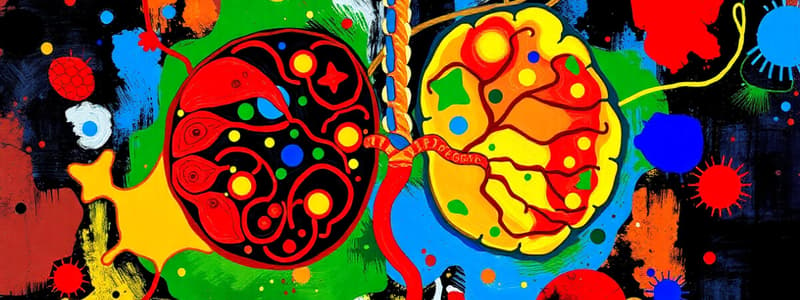Podcast
Questions and Answers
Which statement correctly describes the flow of electrons in the electron transport chain (ETC)?
Which statement correctly describes the flow of electrons in the electron transport chain (ETC)?
- Electrons are transferred from lower to higher energy carriers.
- Electrons accumulate in the intermembrane space and are not transferred.
- Electrons fall to successively lower energy levels as they move through the ETC. (correct)
- Electrons are continuously at a high energy state throughout the ETC.
What role do NADH and FADH2 play in the process of oxidative phosphorylation?
What role do NADH and FADH2 play in the process of oxidative phosphorylation?
- They directly synthesize ATP without any further reactions.
- They act as final electron acceptors in the electron transport chain.
- They are converted back into NAD+ and FAD. (correct)
- They transfer electrons directly to O2.
What is the average ATP yield from one molecule of NADH during oxidative phosphorylation?
What is the average ATP yield from one molecule of NADH during oxidative phosphorylation?
- 5-6 ATP
- 2-3 ATP (correct)
- 3-4 ATP
- 1-2 ATP
In the context of oxidative phosphorylation, what happens to the electrons after they pass through the ETC?
In the context of oxidative phosphorylation, what happens to the electrons after they pass through the ETC?
How do NADH and FADH2 contribute to the regeneration of themselves during cellular respiration?
How do NADH and FADH2 contribute to the regeneration of themselves during cellular respiration?
What is the relationship between the electron transport chain and the production of ATP?
What is the relationship between the electron transport chain and the production of ATP?
What is the function of the intermembrane space in the mitochondrial electron transport chain?
What is the function of the intermembrane space in the mitochondrial electron transport chain?
During oxidative phosphorylation, which of the following accurately describes FADH2's contribution to ATP production?
During oxidative phosphorylation, which of the following accurately describes FADH2's contribution to ATP production?
What key outcome results from the high-energy electrons moving through the carriers of the electron transport chain?
What key outcome results from the high-energy electrons moving through the carriers of the electron transport chain?
What role do H+ ions play in the ATP synthesis process?
What role do H+ ions play in the ATP synthesis process?
Which factor primarily determines the total ATP yield from one glucose molecule in aerobic respiration?
Which factor primarily determines the total ATP yield from one glucose molecule in aerobic respiration?
What is the primary function of glycolysis in cellular respiration?
What is the primary function of glycolysis in cellular respiration?
What is the end product of pyruvate decarboxylation?
What is the end product of pyruvate decarboxylation?
What happens to NADH during anaerobic respiration?
What happens to NADH during anaerobic respiration?
During the electron transport chain, which complex is primarily responsible for using NADH?
During the electron transport chain, which complex is primarily responsible for using NADH?
Which molecule is primarily produced during glycolysis from the breakdown of glucose?
Which molecule is primarily produced during glycolysis from the breakdown of glucose?
What is the primary consequence of the lactic acid buildup in muscles during intense exercise?
What is the primary consequence of the lactic acid buildup in muscles during intense exercise?
In which cellular structure does the electron transport chain occur?
In which cellular structure does the electron transport chain occur?
What role does NADH play in oxidative phosphorylation?
What role does NADH play in oxidative phosphorylation?
What is the final electron acceptor in the electron transport chain?
What is the final electron acceptor in the electron transport chain?
What characterizes the intermembrane space of mitochondria?
What characterizes the intermembrane space of mitochondria?
How many ATP molecules can be generated from one molecule of glucose during aerobic respiration?
How many ATP molecules can be generated from one molecule of glucose during aerobic respiration?
Under which condition does pyruvate degrade into lactate instead of acetyl CoA?
Under which condition does pyruvate degrade into lactate instead of acetyl CoA?
What is the final electron acceptor in the electron transport chain?
What is the final electron acceptor in the electron transport chain?
What is a significant byproduct of the complete oxidation of glucose?
What is a significant byproduct of the complete oxidation of glucose?
How many ATP molecules are synthesized from one molecule of glucose during glycolysis?
How many ATP molecules are synthesized from one molecule of glucose during glycolysis?
What would most likely occur in the absence of the enzyme involved in the first step of converting glycogen to glucose?
What would most likely occur in the absence of the enzyme involved in the first step of converting glycogen to glucose?
What role do FADH2 contribute in ATP synthesis compared to NADH?
What role do FADH2 contribute in ATP synthesis compared to NADH?
What is the impact of FADH2 in the electron transport chain compared to NADH?
What is the impact of FADH2 in the electron transport chain compared to NADH?
What is released during the transformation of pyruvate into Acetyl CoA?
What is released during the transformation of pyruvate into Acetyl CoA?
In the Citric Acid Cycle, which molecule is primarily regenerated to continue the cycle?
In the Citric Acid Cycle, which molecule is primarily regenerated to continue the cycle?
How many molecules of ATP are generated from one complete cycle of the Citric Acid Cycle?
How many molecules of ATP are generated from one complete cycle of the Citric Acid Cycle?
Which of the following is NOT a product of the Citric Acid Cycle?
Which of the following is NOT a product of the Citric Acid Cycle?
During oxidative phosphorylation, where are most of the electron carrier molecules located?
During oxidative phosphorylation, where are most of the electron carrier molecules located?
What is the primary role of NADH and FADH2 in cellular respiration?
What is the primary role of NADH and FADH2 in cellular respiration?
Where does the processing of Acetyl CoA mainly release energy to form GTP?
Where does the processing of Acetyl CoA mainly release energy to form GTP?
What happens to hydrogen atoms during the processes of the Citric Acid Cycle and the Electron Transport Chain?
What happens to hydrogen atoms during the processes of the Citric Acid Cycle and the Electron Transport Chain?
What is the main source of oxygen used in the formation of carbon dioxide during the Citric Acid Cycle?
What is the main source of oxygen used in the formation of carbon dioxide during the Citric Acid Cycle?
In oxidative phosphorylation, what is primarily produced by the electron transport chain?
In oxidative phosphorylation, what is primarily produced by the electron transport chain?
Flashcards are hidden until you start studying
Study Notes
Cellular Metabolism Overview
- Cellular respiration occurs under aerobic conditions, producing a maximum of 32 ATP from one glucose molecule.
- Breakdown includes:
- 2 ATP from glycolysis
- 2 ATP from the TCA (Krebs) cycle
- 3 ATP from FADH2 (2 molecules of FADH2 yield 3 ATP)
- 25 ATP from NADH (10 NADH yield 25 ATP)
Oxidative Phosphorylation
- Oxygen plays a crucial role in oxidative phosphorylation by accepting electrons and producing water.
- NADH and FADH2 donate electrons to the electron transport chain (ETC), regenerating NAD+ and FAD for reuse in metabolic processes.
- Each NADH generates approximately 2.5 ATP, while each FADH2 generates around 1.5 ATP.
- High-energy electrons fall through multiple carriers in the ETC, releasing energy to pump H+ ions into the intermembrane space.
- The resulting H+ gradient powers ATP synthase to synthesize ATP as H+ ions return to the mitochondrial matrix.
- Oxygen serves as the final electron acceptor to maintain the flow of electrons in the chain.
Anaerobic Conditions
- In the absence of oxygen, pyruvate is converted to lactate instead of acetyl CoA.
- Cellular respiration is limited to glycolysis, generating only 2 ATP.
- NADH produced during glycolysis is reused to convert pyruvate to lactic acid, preventing buildup of NAD+.
- Metabolic activities at high intensity can lead to lactic acid accumulation, causing muscle fatigue and dysfunction.
Key Processes in Cellular Respiration
-
Pyruvate Decarboxylation:
- Converts pyruvate to Acetyl CoA as it enters the mitochondrial matrix, releasing one CO2 and generating one NADH per pyruvate.
-
Citric Acid Cycle (TCA Cycle):
- Consists of 8 enzymatic reactions, regenerating oxaloacetate and releasing two CO2 per cycle.
- Produces 6 NADH and 2 FADH2 while generating 2 ATP (1 per cycle).
- Hydrogen atoms from substrates are captured in carrier molecules (NAD+ and FAD) for use in the ETC.
Glycolysis
- Glycolysis breaks down one glucose molecule into two pyruvate molecules through a series of 10 enzyme-mediated reactions.
- Produces:
- 2 NADH (from NAD+)
- 2 ATP directly from substrate-level phosphorylation.
- Several metabolic diseases can impact glycolysis; for example, McArdle disease results from a deficiency in the enzyme needed to convert glycogen to glucose.
Electron Transport Chain (ETC)
- Resides in the inner mitochondrial membrane, comprising a series of electron carriers.
- Extracts high-energy electrons from NADH and FADH2, facilitating the majority of ATP production.
- The process transforms energy between mitochondrial compartments (matrix to membrane) to create a usable form of energy (ATP) for the cell.
Studying That Suits You
Use AI to generate personalized quizzes and flashcards to suit your learning preferences.




